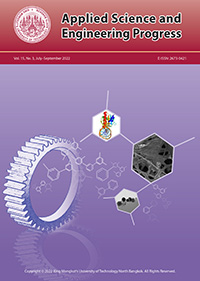Avoiding Covid-19 Using a 3D Digital Mock Up and Augmented Reality with Cobot in Digital Factory
Main Article Content
Abstract
The Fourth Industrial Revolution or Industry 4.0 is extremely relevant and important in manufacturing for several reasons. Failing to adopt the technology of the Fourth Industrial Revolution can cause organizations to fall behind, as their operations are not digitized enough in benchmarking competitors. A major industry as bicycle manufacturing needs to be transformed into a digital factory in order to keep up with the evolving technology. The objectives of this research are in designing a 3D digital mock up and Augmented Reality (AR) for bicycle frame production in the form of digital factory for increasing production capability by decreasing the break-even point whilst avoiding Covid-19 contraction using Tecnomatix Plant Simulation and Unity 3D programs. This research constructed three alternative digital factory layouts that are designed by using a 3D simulation program. The risk of Covid-19 contraction points and the three layouts of cost per unit are analyzed. The results show that the break-even point of the first to the third layouts with Automated Guided Vehicle (AGV) are 26,580, 26,322 and 25,354 units respectively. The result of the risk about Covid-19 contraction points from the first to the third layout with AGV are 21,272, 2,872 and 0 points respectively. This means the most appropriate layout for bicycle frame production is the third layout due to the best break-even point that can significantly avoid Covid-19 contraction. The benefit of this research is to integrate a 3D digital mock up, AR and Cobot including AGV to assist the resilience of operations with a dynamic industrial environment.
Article Details
References
H. Yu, X. Sun, W. D. Solvang, and X. Zhao, “Reverse logistics network design for effective management of medical waste in epidemic outbreaks: Insights from the Coronavirus Disease 2019 (COVID-19) outbreak in Wuhan (China),” International Journal of Environmental Research and Public Health, vol. 17, no. 5, 2020, Art. no. 1770, doi: 10.3390/ijerph17051770.
H. A. Rothan and S. N. Byrareddy, “The epidemiology and pathogenesis of coronavirus disease (COVID-19) outbreak,” Journal of Autoimmunity, vol. 109, 2020, Art. no. 102433, doi: 10.1016/j.jaut.2020.102433.
S. Buranyi, “The WHO v coronavirus: Why it can't handle the pandemic,” 2020. [Online]. Available: https://www.theguardian.com/news/ audio/2020/may/01/the-who-v-coronavirus-whyit- cant-handle-the-pandemic-podcast
A. Kengpol and C. Chanchittakarn, “The influence of vertical centrifugal casting on nickel aluminum bronze alloy for using in the Royal Thai Navy,” Applied Science and Engineering Progress, vol. 14, no. 3, pp. 503–510, 2021, doi: 10.14416/j. asep.2020.04.005.
A. Kengpol and S. Tuammee, “The development of a decision support framework for a quantitative risk assessment in multimodal green logistics: An empirical study,” International Journal of Production Research, vol. 54, pp. 1020–1038, 2016, doi: 10.1080/00207543.2 015.1041570.
A. Caggiano and R. TetiAn, “Digital factory technologies for robotic automation and enhanced manufacturing cell design,” Cogent Engineering, vol. 5, no. 1, 2018, Art. no. 1426676, doi: 10.1080/ 23311916.2018.1426676.
M. Gregor and S. Medvecky, “Digital factory – theory and practice,” in Engineering the Future, Croatia: InTech, 2010, pp. 355–376.
R. Geissbauer, S. Schrauf, P. Berttram, and F. Cheraghi, “Digital factories 2020: Shaping the future of manufacturing,” 2017. [Online]. Available: https://www.pwc.de/de/digitaletransformation/ digital-factories-2020-shapingthe- future-of-manufacturing.pdf
G. Guizzia, D. Falconeb, and F. D. Feliceb, “An integrated and parametric simulation model to improve production and maintenance processes: Towards a digital factory performance,” Computers & Industrial Engineering, vol. 137, no. 2, 2019, Art. no. 106052, doi: 10.1016/j.cie.2019.106052.
V. Naranje, P. V. Reddy, and B. K. Sharma, “Optimization of factory layout design using simulation tool,” in 2019 IEEE 6th International Conference on Industrial Engineering and Applications (ICIEA), 2019, doi: 10.1109/ IEA.2019.8715162.
S. C. Sekaran, H. J. Yap, S. N. Musa, K. E. Liew, C. H. Tan, and A. Aman, “The implementation of virtual reality in digital factory,” The International Journal of Advanced Manufacturing Technology, vol. 115, pp. 1349–1366, 2021.
A. Duangsuphasin, P. Rungsaksangmanee, A. Kengpol, and K. Elfvengren, “The development of deep learning methods to select passion fruit for the ageing society,” in 2021 Research, Invention, and Innovation Congress: Innovation Electricals and Electronics (RI2C), 2021, doi: 10.1109/ RI2C51727.2021.9559796.


